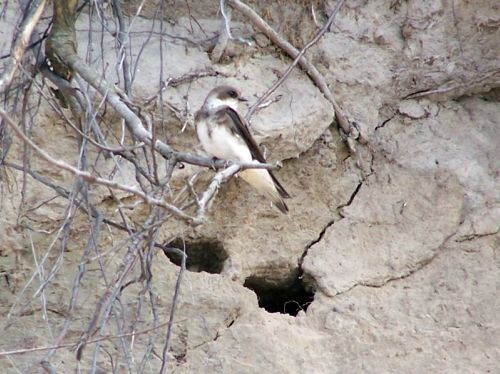March 23
Posted by sydney on Mar 23rd, 2009

Sand-martin with nest holes, picture by Ejdzej courtesy of Wikipedia
- 1792: March 23, 1792 – Timothy the Tortoise comes out. Crown imperials bud for bloom, & stink much.
- 1791: March 23, 1791 – Soft wind. The wood-pecker laughs.
- 1788: March 23, 1788 – Mr Churton, who was this week on a visit at Waverley, took the opportunity of examining some of the holes in the sand-banks with which that district abounds. As these are undoubtedly bored by bank-martins, & are the places where they avowedly breed, he was in hopes they might have slept there also, & that he might have surprised them just as they were awakening from their winter slumbers. When he had dug for some time he found the holes were horizontal & serpentine, as I had observed before; & that the nests were deposited at the inner end, & had been occupied by broods in former summers: but no torpid birds were to be found. He opened & examined about a dozen holes. Mr Peter Collinson made the same search many years ago, with as little success. These holes were in depth about two feet.
- 1787: March 23, 1787 – Timothy hides his head under the earth.
- 1782: March 23, 1782 – A farmer tells me he foresaw this extraordinary weather by the prognostic deportment of his flock; which, when turned-out on a down two or three mornings ago, gamboled & frolicked about like so many lambs.
- 1775: March 23, 1775 – Earthworms travel about in rainy nights, as appears from their sinuous tracks on the soft muddy soil, perhaps in search of food.
- 1773: March 23, 1773 – Coluber natrix. Summer weather with a brisk wind. Cock & hen wheatear.
- 1772: March 23, 1772 – Tussilago farfara. Considerable mischief was done by this storm near & in London.
- 1771: March 23, 1771 – Severe frost, sun, & flights of snow. Cutting wind. Dr. Johnson says “that in 1771 the season was so severe in the island of Sky, that it is remembered by the name of the black spring. The snow, which seldom lies at all, covered the ground for eight weeks, many cattle dyed, & those that survived were so emaciated & dispirited that they did not require the male at the usual season.” The case was just the same with us here in the South: never were so many barren cows known as in the spring following that dreadful period. Whole dairies missed being in calf together.
- 1770: March 23, 1770 – Thermometer abroad sunk to 29. Plows are frozen out. Great Northern aurora.
- 1769: March 23, 1769 – Regulus non cristatus minimus. This bird appears the first of any of the summer-birds of passage, the jynx, or wryneck sometimes excepted. It has only two harsh shrill notes. Fine season for the husbandman.
Notes:
Into the mid-19th century debate raged in the natural philosophy community as to whether swallows and martins migrate or hibernate. Actually, there is one species of bird that does hibernate— an american relation of the nightjar or goat-sucker that often appears in these journals.
Coluber natrix– common grass-snake, now called Natrix natrix.
Tussilago farfara-Common coltsfoot.
Regulus non crisatus minimus– the chiff chaff.
 Theme Ported to
Theme Ported to